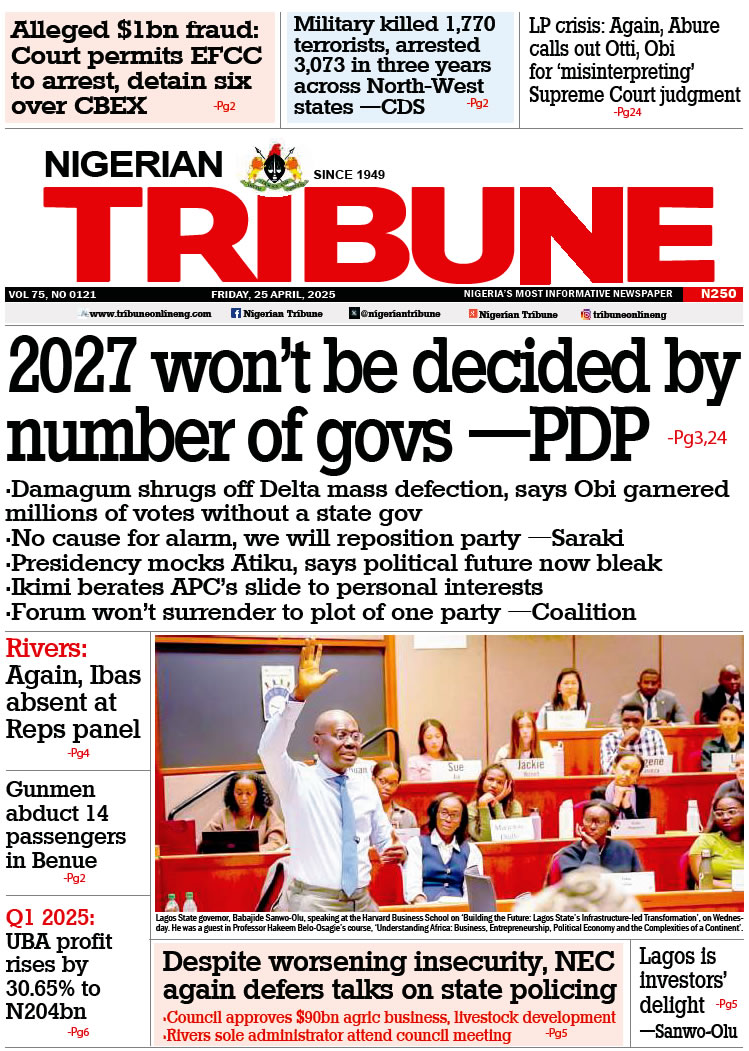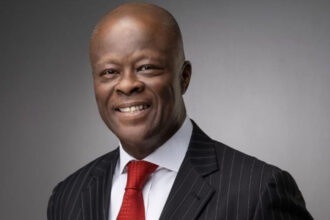Fitch, a global rating agency recently warned the Federal Government of Nigeria against repeated recourse to ways and means financing (WMF) from Central Bank of Nigeria (CBN). In this analysis, CHIMA NWOKOJI examines the implication of continuous borrowing from the apex bank above the limit stipulated in the Act.
FOLLOWING the Federal Government’s failure to meet its revenue targets due to the impact of the fall in oil prices and COVID-19 pandemic, the Central Bank of Nigeria (CBN) gave a total of N2.8 trillion in support loans to FG in 2020.
The support came in the form of Ways and Means, a provision in the CBN Act that allows the government to borrow from the Apex Bank. Provisions in the act pegged monetary financing of fiscal deficits at five per cent of the prior year’s revenues, but Nigerian Tribune analysis show that the Federal Government has borrowed above this threshold. The provision also requires that the loans are repaid at the end of the year or else the CBN will no longer be able to lend to the government in the following year.
At N2.8 trillion, the CBN basically lent the government 52.8 per cent of its current year revenues or 62.2 per cent of 2019 revenues of N4.5 trillion.
However, the FGN’s new borrowing from the CBN has repeatedly exceeded that limit in recent years, and reaching about 80per cent of the FGN’s 2019 revenues in 2020, some analysts say, appears to violate the CBN Act, that the outstanding amount should not exceed five per cent of prior years’ actual revenue.
Prior to the implementation of the 2021 budget, Fitch Ratings estimates that the balance of the government’s WMF with the CBN was around N9.8 trillion (6.7 per cent of GDP) at end-2019, up from N5.4 trillion (4.2 per cent of GDP) at end-2018. Some analysts believe it is even higher than that.
In a report last week, Fitch Global rating agency expressed concern over this development, warning the Federal Government against repeated recourse to this window. It said “sustained use of direct monetary financing could raise risks to macroeconomic stability – given the current weak institutional safeguards – but we expect the FGN to reduce its use of the facility in 2021.”
Fitch’s warning is coming after the government’s Ways and Means financing was brought to public view in 2016, after the former CBN Governor, Sanusi Lamido Sanusi accused the government of contravening the CBN Act by borrowing more than the required five per cent of prior year revenues.
Meanwhile, the Minister for Finance, Zainab Ahmed during a public presentation of the 2021 FGN Approved Budget – Breakdown & Highlights which was done via Zoom, an online platform for virtual meetings, confirmed that the central bank provided financial support to the tune of N2.8 trillion which the government used to fund its budget expenditure.
In the breakdown, out of the 2020 budget deficit of N6.1 trillion, N2 trillion was sourced from domestic borrowing and another N1.2 trillion from foreign borrowing. The rest was via Ways and Means.
Out of the N5.3 trillion in budgeted revenue, only N3.9 trillion was generated as actual, resulting in a 27 per cent revenue shortfall for the year, according to her.
However, in terms of expenditure, while N9.97 trillion was appropriated, N10.08 trillion (representing 101 per cent) was spent during the year.
The shortfall in revenues and increased spending resulted in an actual deficit spending of N6.1 trillion as against N4.6 trillion budgeted during the year
Nigeria also increased its debt service from N2.9 trillion to N3.2 trillion, just as interest on Ways and Means totaling N912.5 billion contributed significantly to the cost.
A herd of economic and finance experts have also lent their voices on the implications of massive borrowing through WMF. While some view this as a struggle to keep afloat as the “government is broke,” others see the trend as a sign of poor management of the country’s resources which does not augur well to citizens.
The Group Managing Director, Afrinvest West Africa, Mr Ike Chioke, described the ways and means as a situation where the Central Bank of Nigeria prints money and gives to the government. According to him, this is worrying because it is not sustainable, having risen dramatically from N2.2 trillion in 2016, and is currently estimated at N10 trillion in 2020.
He expressed concern about the nation’s debt stock during presentation of the Afrinvest 2020 Nigerian Banking Sector Report titled ‘The insecurity challenges of poverty,’ which was launched recently.
Chioke’s words “Our debt position has risen from N15.7 trillion in 2016 to now approaching N38 trillion estimated at 2020. Another part of the component of debt, which is often not visible to most people, is the ways and means, which is the Central Bank of Nigeria printing money and giving to the government and that has also risen dramatically from N2.2 trillion in 2016, and is currently estimated at N10 trillion in 2020.
“They are very worrying numbers because you can see that the Federal Government’s debt-to-GDP ratio is now at 28 per cent and while that may seem reasonable, by most accounts, it is more worrying when you look at debt sustainability and compare our debt service to revenue.
“In 2016, debt service to revenue was only 44.6 per cent and in 2020 we are looking at debt service to revenue of 84.8 per cent which is a very worrisome number indeed.”
“We have a fractured situation where there is not even confidence in the sovereign to start with and when you don’t have confidence in a financial arrangement in the way that the sovereign has set itself up to do business in the eyes of the world, domestic commercial market, local capital markets, you can imagine how hard it is for everybody else that is further down the hierarchy to establish that confidence.”
The Federal Government has revealed plans to convert its total loans from the CBN in 2020 into formal borrowings by designing “special instruments” that could be repackaged and sold as bonds. Available records show that the FG had partly financed the N6.1trllion deficit for 2020 by “Ways and Means” and is also likely to do so again in 2021.
The Managing Director, Financial Derivatives Company Limited (FDC), Mr Bismarck Rewane fears that the impact of this financial arrangement will be a huge injection of over N11 trillion into the fixed income market in 2021 which would trigger a rise in fixed income yields.
This supports the forecast of a shift to a higher interest rate environment in 2021 and could also have negative consequences for liquidity in the equities markets which has been one of the biggest beneficiaries of the lack of fixed income securities.
The Federal Government, will also increase its total borrowings, now at $73.57 billion, but will not take any new facilities from the International Monetary Fund (IMF).
Mr Rewane in his firm’s economic bulletin said though the Federal government’s decision will ease the pressure on mounting external debt and exchange rate volatility, domestic debt issuances will increase as a result, crowding out private sector borrowing.
“With inflation skyrocketing, the switch to a higher interest rate environment is now almost inevitable in the near term and this will exacerbate the governments financing pressures as the cost of servicing domestic debt would rise,” he stated
The year 2020 was an exceptional year globally due to the COVID-19 pandemic and expectedly impacted government revenues negatively due to the lockdown and the fall in oil prices. Without the central bank backstopping these loans, it might have been practically impossible for the government to fund its expenditure programs for 2020.
While noting that a number of emerging markets resorted to central bank deficit financing in 2020 against a background of urgent spending needs and temporary market dislocations associated with the COVID-19 pandemic, Fitch maintains that the use of central bank financing in Nigeria predates the pandemic shock.
According to the agency, repeated central bank financing of government budgets could raise risks to macro-stability in the context of weak institutional safeguards that preserve the credibility of policymaking and the ability of the central bank to control inflation.
It corroborated the fact that the government has stated its intention to securitise balances borrowed under the facility, but published statistics indicate that the amounts borrowed have been rolled over repeatedly in recent years.
Data published by the government indicate that the treasury paid N912.6 billion on the facility in 2020, equivalent to nine per cent only of the outstanding balance at end- 2019.
According to Fitch, the repeated resort to CBN thus reflects higher-than-expected deficits, pointing to entrenched weaknesses in public finance management. It however, viewed the Nigerian government’s fiscal revenue and expenditure projections for 2021 as broadly realistic, which should preclude further significant borrowing by the sovereign from the CBN facility this year. But stakeholders in some quarters do not believe that the budget projections are realisable.
The government may nonetheless use the facility more extensively if the deficit proves wider than forecast or if external financing falls short of planned amounts.
Further on the implications, Fitch said monetary financing of the fiscal deficit raises challenges to monetary policy implementation, as tight management of domestic liquidity is a key tool under the CBN’s policy of prioritising the stability of the naira, even as the WMF could also complicate official efforts to bring inflation back under control.
“High inflation in Nigeria is a credit weakness. Nigeria’s consumer prices rose by 15.7 per cent year-on-year in December 2020. However, at present, we view inflation as being driven primarily by cost-push factors – including restrictions on access to foreign exchange for imports, the impact of border closures on trade, hikes in minimum wages and VAT, and the removal of the fuel subsidy – rather than overly loose monetary policy,” it stated.
The yoke of debt service
The Federal Government of Nigeria achieved a debt service to revenue ratio of 83 per cent in 2020. This is according to the information contained in the budget implementation report of the government for the year ended December 2020.
According to the data, total revenue earned in 2020 was N3.93 trillion representing a 27 per cent drop from the target revenues of N5.365 trillion. However, debt service for the year was a sum of N3.26 trillion or 82.9 per cent of revenue.
Nigeria’s debt service cost of N3.26 trillion has now dwarfed the N1.7 trillion spent on capital expenditure of N1.7 trillion incurred in 2020. This is also the highest debt service paid by the Federal Government since 2009.
The total public debt (External and Domestic) balance carried by Nigeria as of September 2020 stood at N32.22 trillion ($84.57 billion). Included in the total debt is a domestic debt of about N15.8 trillion.
Analysts say Nigeria’s debt to GDP ratio is estimated at about 22 per cent, one of the lowest in the world and much below what is obtainable in most emerging markets. But the challenge has always been the debt service to revenue ratio, a metric that reveals whether the government is generating enough revenues to pay down its debts as they mature.
Generally, the country’s borrowing space under the International Monetary Fund (IMF) debt sustainability threshold is 45 per cent for Nigeria and other low-middle income countries.
Sustainable debt is the level of debt which allows a debtor country to meet its current and future debt services obligations in full, without recourse to further debt relief or rescheduling, avoiding accumulation of arrears, while allowing an acceptable level of economic growth or without compromising growth. IMF debt sustainability threshold is seen as a measure of a country’s solvency, that is, a countries ability to ensure that accumulated debts are serviced without defaulting and if countries are able to sustain their debt servicing overtime.
Since the first recession experienced in 2016, Nigeria has struggled with a higher debt service to revenue ratio as revenues slid in direct correlation with the fall in oil prices.
Nigeria’s government spent about N2.45 trillion in debt service in 2019 out of total revenue of N4.1 trillion or 59.6 per cent debt service to revenue ratio.
At 83 per cent, 2020 ranks as the highest debt service to revenue ratio the country has incurred. Before now it was 2017 with 61.6 per cent.
Nigerian Tribune findings show that the government only contributed N4.58 billion into its sinking fund instead of the budgeted N272.9 billion. The sinking fund is required to set aside funds that will be used to pay down on other loans such as bonds when they mature in the future.
In 2021, the government projects a debt service of N3.1 trillion against revenue of N6.6 trillion or debt service to revenue ratio of 46.9 per cent.
YOU SHOULD NOT MISS THESE HEADLINES FROM NIGERIAN TRIBUNE
INEC Lists Five Challenges Ahead Of 2023 Elections
AS politicians step up horse-trading ahead of subsequent elections, the Independent National Electoral Commission (INEC) has listed five main areas of likely challenges…
Who Succeeds IGP Mohammed Adamu?
As the February retirement date of the incumbent Inspector General of Police (IGP), Mohammed Adamu draws near, there are varying permutations on who steps in as the new police boss. SUNDAY ADEPOJU writes on the suspense over the…
After Two Years, Daddy Freeze Apologises To Bishop Oyedepo
Daddy Freeze whose real name is Ifedayo Olarinde has apologised to Bishop Oyedepo who is the presiding bishop and founder of Living Faith Church aka Winners Chapel…








